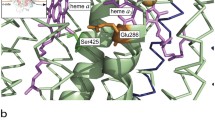Abstract
The individual rate constants for intramolecular electron transfer (IET) between the MoVIFeII and MoVFeIII forms of chicken liver sulfite oxidase (SO) have been determined at a variety of pH values, and at high and low anion concentrations. Large anions such as EDTA do not inhibit IET as dramatically as do small anions such as SO4 2– and Cl–, which suggests that specific anion binding at the sterically constrained Mo active site is necessary for IET inhibition to occur.IET may require that SO adopt a conformation in which the Mo and Fe centers are held in close proximity by electrostatic interactions between the predominantly positively charged Mo active site, and the negatively charged heme edge. Thus, small anions which can fit into the Mo active site will weaken this electrostatic attraction and disfavor IET. The rate constant for IET from FeII to MoVI decreases with increasing pH, both in the presence and absence of 50 mM SO4 2–. However, the rate constant for the reverse process exhibits no significant pH dependence in the absence of SO4 2–, and increases with pH in the presence of 50 mM SO4 2–. This behavior is consistent with a mechanism in which IET from MoV to FeIII is coupled to proton transfer from MoV–OH to OH–, and the reverse IET process is coupled to proton transfer from H2O to MoVI=O. At high concentrations of small anions, direct access of H2O or OH–to the Mo-OH will be blocked, which provides a second possible mechanism for inhibition of IET by such anions. Inhibition by anions is not strictly competitive, however, and Tyr322 may play an important intermediary role in transferring the proton when an anion blocks direct access of H2O or OH– to the Mo-OH. Competing H-bonding interactions of the Mo-OH moiety with Tyr322 and with the anion occupying the active site may also be responsible for the well-known equilibrium between two EPR-distinct forms of SO that is observed for the two-electron reduced enzyme.
Similar content being viewed by others
Author information
Authors and Affiliations
Additional information
Received: 21 December 1998 / Accepted: 6 April 1999
Rights and permissions
About this article
Cite this article
Pacheco, A., Hazzard, J., Tollin, G. et al. The pH dependence of intramolecular electron transfer rates in sulfite oxidase at high and low anion concentrations. JBIC 4, 390–401 (1999). https://doi.org/10.1007/s007750050325
Issue Date:
DOI: https://doi.org/10.1007/s007750050325




